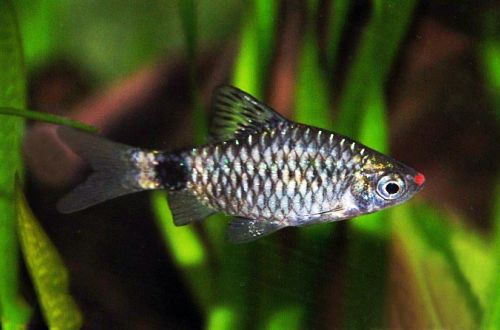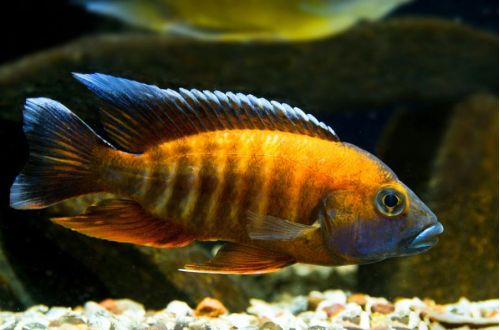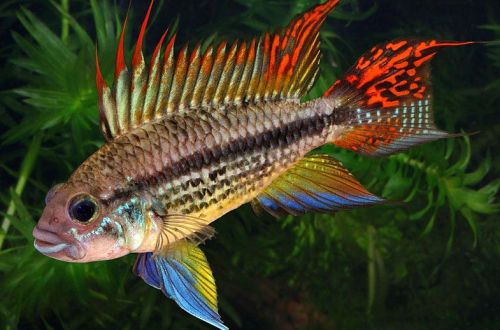
Tulip Barb
The Tulip Barb, scientific name Pethia erythromycter, belongs to the Cyprinidae family. The fish went on sale in 2006. It is one of the species that require a certain experience from the aquarist to keep it, therefore it is not recommended for beginners.

Contents
Habitat
It comes from Southeast Asia from the territory of Northern Myanmar, where it lives in the upper basin of the Ayeyarwaddy River and the vicinity of Lake Indogia. The natural habitat is characterized by clear running water, soft substrates rich in clay mixed with fallen vegetation, and dense thickets of aquatic plants.
Brief information:
- The volume of the aquarium – from 100 liters.
- Temperature – 18-24°C
- Value pH — 7.0–7.5
- Water hardness – 1–12 dGH
- Substrate type – any dark
- Lighting is weak
- Brackish water – no
- Water movement is weak
- The size of the fish is about 3-3,5 cm.
- Feeding – any food of suitable size
- Temperament – conditionally peaceful
- Content in a group of 10 individuals
Description
Adults reach a length of about 3 cm. The color is silver with a dark stroke at the base of the tail. Males, unlike females, have red pigmentation around the mouth, and with the onset of the mating season, they acquire a rich “steel” color.
Food
A low-fat dietary species, accepts most popular aquarium fish foods of a suitable size. The composition and quality of the feed directly affects the color of the fish and the appearance of healthy fry, so you should give preference to products from well-known and trusted manufacturers.
Maintenance and care, arrangement of the aquarium
Despite the modest size of the Tulip Barb, the optimal volume of the aquarium for a small flock of these fish starts from 100 liters, which is due to the peculiarities of their behavior, more on that below. The design uses a large number of aquatic plants and various shelters in the form of snags and branches or decorative objects (wrecks, castles, etc.). The lighting is subdued.
Comfortable conditions of keeping have a rather narrow range of hydrochemical values and temperatures, in addition, the fish need very clean water and do not tolerate even minor pollution. In addition to a productive filtration system, the obligatory aquarium care procedures are: weekly replacement of part of the water (at least 30% of the volume) with fresh water, regular removal of organic waste (food residue, excrement), equipment maintenance, monitoring and maintaining stable pH, dGH values , oxidizability.
Behavior and Compatibility
Conditionally peaceful fish. Although quite small, it can still cause problems for slow-moving fish with long veiled fins, which the Tulip Barb loves to nibble on. As neighbors in the aquarium, it is recommended to select active fish of a similar size.
Intraspecific relationships are built on the competition of males for the attention of females, and quite aggressively. The degree of hostility can be reduced by the large size of the aquarium, being in a flock of more than 20 individuals, or when there are at least 4 females per male.
Breeding / breeding
Under favorable conditions, spawning is possible in a common aquarium. Females scatter eggs in the water column, and males fertilize them. The incubation period lasts 24-36 hours, in the next couple of days the fry that appear begin to swim freely. In the early days, they need microscopic food in the form of shoe ciliates; as they grow older, brine shrimp nauplii or powdered food can become the basis of the diet. It is worth noting that there is no parental care for the offspring, moreover, adult fish, on occasion, will gladly feast on their own juveniles.
In order to protect offspring from predation by other fish, it is recommended to prepare in advance a separate tank with identical water conditions – a spawning aquarium, where eggs are placed after spawning is completed. Usually, it is equipped with a simple airlift filter with a sponge and a heater. A separate light source is not required, the light coming from the room is sufficient.
Fish diseases
In a balanced aquarium ecosystem with species-specific conditions, diseases rarely occur. Diseases are caused by environmental degradation, contact with sick fish, and injuries. If this could not be avoided, then more about the symptoms and methods of treatment in the section “Diseases of aquarium fish”.





